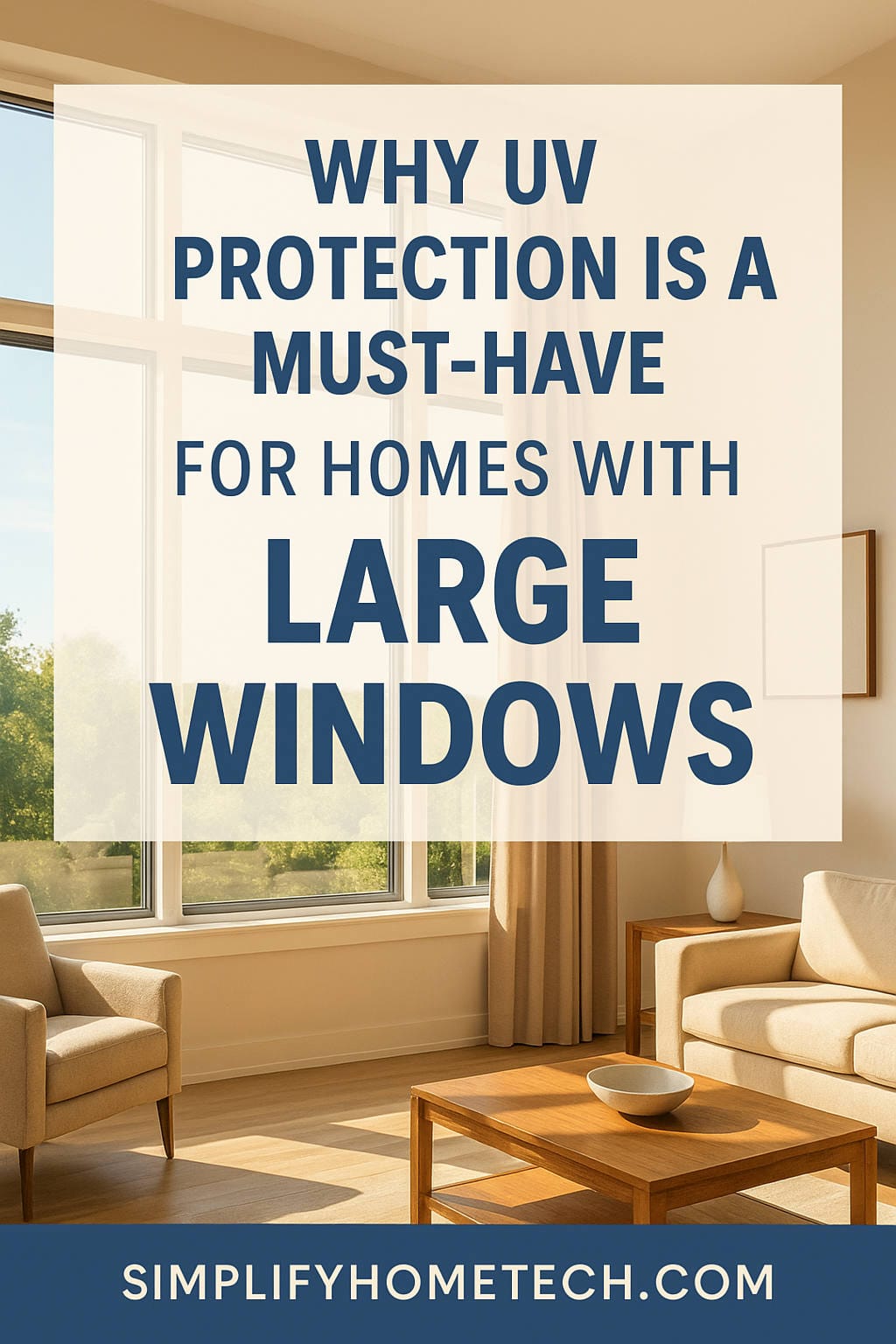Homes with large windows are a timeless architectural trend that continues to grow in popularity. They invite natural light, create an airy ambiance, and offer stunning views of the outdoors. But as beautiful and beneficial as these expansive glass features are, they come with a hidden downside: exposure to harmful ultraviolet (UV) rays.
You might assume that being indoors shields you from the sun’s harmful effects, but that’s not entirely true. UV radiation can pass through standard glass and cause various issues for both your home and your health. In this in-depth guide, we’ll explore why UV protection is crucial for homes with large windows, how UV rays can impact your living space, and the best solutions to protect what matters most.
Understanding UV Radiation
UV radiation is a part of the electromagnetic spectrum emitted by the sun. Although invisible to the naked eye, these rays can significantly impact your health and home environment. UV rays are categorized into three types:
- UVA (320-400 nm): These rays penetrate deep into the skin and can pass through window glass. They’re associated with skin aging and long-term health issues.
- UVB (290-320 nm): UVB rays are largely responsible for sunburns and can also pass through some types of glass.
- UVC (100-290 nm): These are mostly absorbed by the Earth’s atmosphere and pose minimal risk to us directly.
While most of us are familiar with the dangers of UV exposure outdoors, it’s easy to overlook the risks posed by prolonged exposure indoors through large, untreated windows.
The Hidden Dangers of UV Exposure Inside Your Home
1. Fading and Damage to Interior Furnishings
UV radiation is notorious for causing colors to fade and materials to degrade over time. If your home features large windows, the constant exposure to sunlight can lead to noticeable damage in a short amount of time.
Common household items affected include:
- Hardwood floors
- Carpets and rugs
- Upholstered furniture
- Curtains and drapes
- Wall art and photographs
- Leather and wood finishes
Even high-end furnishings are not immune. What starts as subtle discoloration can quickly become costly damage that diminishes the visual appeal and value of your interior.
2. Increased Health Risks
Most people associate UV damage with beach days and outdoor activities. However, studies show that up to 50% of UVA rays can penetrate regular window glass. This means that sitting by a sunny window for hours can expose you to harmful radiation without you even realizing it.
Long-term indoor UV exposure can lead to:
- Skin aging and wrinkles
- Hyperpigmentation and age spots
- Eye strain and increased risk of cataracts
- Higher likelihood of skin cancer
If you work from home or spend significant time near windows, the risk is amplified. UV protection becomes not just a design choice but a health imperative.
3. Rising Energy Bills and Temperature Imbalance
UV rays don’t just bring light into your home—they also bring heat. During the warmer months, homes with large unprotected windows often struggle with overheating. This creates hot spots in certain rooms and forces your air conditioning to work harder.
In colder seasons, untreated glass can also lead to significant heat loss, making it difficult to maintain a stable indoor temperature. The end result? Higher energy bills and an uncomfortable living environment.
4. Annoying Glare and Reduced Visual Comfort
Abundant sunlight can be beautiful, but it can also lead to intense glare, especially during certain times of the day. This can be particularly disruptive when watching TV, working on a computer, or reading.
Excessive glare strains your eyes and reduces overall comfort, diminishing the benefits of having large windows in the first place.
The Benefits of Adding UV Protection to Large Windows
Installing UV protection on your home’s windows isn’t just about preventing problems—it’s also about improving the quality of life inside your home.
1. Prolong the Life of Your Interiors
By blocking out harmful rays, UV protection helps preserve the color, texture, and integrity of your furnishings. Your hardwood floors remain rich and vibrant, your furniture retains its beauty, and your artwork stays protected for years.
2. Enhance Personal Health and Wellness
Protecting your skin and eyes from UV exposure indoors is just as crucial as using sunscreen outside. With effective window treatments, you can enjoy natural light without the accompanying health risks.
This is especially beneficial for families with young children, elderly residents, or individuals with sensitive skin.
3. Improve Energy Efficiency
Many modern UV-blocking solutions also offer heat-reduction benefits. By filtering out solar heat, your HVAC system won’t need to work as hard, resulting in lower energy bills and a more environmentally friendly home.
Plus, a well-regulated indoor temperature enhances overall comfort, making your living space enjoyable year-round.
4. Reduce Glare Without Losing Natural Light
Contrary to popular belief, UV protection doesn’t mean sacrificing sunlight. Today’s window films and coatings are designed to filter harmful rays while maintaining clarity and brightness. You get the beauty of natural daylight without the drawbacks of glare or heat.
Top UV Protection Solutions for Residential Windows
If you’re looking to upgrade your home’s UV defenses, here are some of the best options available:
1. Window Films
Window films are thin, transparent layers applied directly to existing glass surfaces. They come in various shades and finishes, including clear, tinted, or reflective options.
Benefits:
- Blocks up to 99% of UV rays
- Reduces heat and glare
- Enhances privacy
- Cost-effective and easy to install
Many homeowners choose window films because they offer protection without altering the look of the window significantly.
2. Low-E (Low-Emissivity) Glass
Low-E glass has a special microscopic coating that reflects infrared and UV light. This type of glass is often used in energy-efficient windows and is ideal for new installations or major renovations.
Benefits:
- Built-in UV and thermal protection
- Excellent insulation
- Long-lasting performance
- Potential for energy rebates
While the upfront cost is higher, Low-E windows pay off in energy savings and increased comfort over time.
3. Smart Glass (Electrochromic Windows)
Smart glass technology allows windows to change their tint automatically based on sunlight intensity or manual settings. It’s an innovative and modern solution for high-tech homes.
Benefits:
- Adjustable UV and light control
- Improved temperature regulation
- High-end aesthetic appeal
Smart glass tends to be more expensive but is perfect for luxury homes or tech-forward renovations.
4. UV-Blocking Window Treatments
Not all protection needs to be high-tech. Many curtains, blinds, and shades now come with UV-resistant fabrics designed to block sunlight while complementing your decor.
Benefits:
- Flexible style options
- Partial or full UV blocking
- Easy to integrate into existing interiors
This is a great choice for rooms where you want light control and UV protection with a decorative touch.
5. Outdoor Shading Solutions
External additions like awnings, pergolas, and solar screens can prevent sunlight from directly hitting your windows in the first place.
Benefits:
- Prevents UV at the source
- Cools exterior surfaces
- Adds architectural interest
These solutions pair well with interior options to create a comprehensive UV defense system.
How to Choose the Right UV Protection Strategy
Every home is different, and the best solution depends on your specific needs. Here’s what to consider:
- Window orientation: South- and west-facing windows receive the most intense sunlight.
- Budget: Films are more affordable; smart glass and Low-E windows are a bigger investment.
- Home age: New builds can integrate Low-E glass more easily, while films are ideal for retrofits.
- Aesthetic preference: Choose between clear and tinted options based on how much visibility and light you want.
Consulting with a window professional can help you evaluate your exposure and recommend the best combination of products.
Real-Life Scenarios: Why UV Protection Matters
Case Study 1: The Fading Living Room
A couple noticed their expensive leather sofa and oak flooring fading just a year after moving into a home with floor-to-ceiling windows. After installing UV-blocking window film, the fading stopped completely. They preserved their interior and saved thousands in potential repairs.
Case Study 2: Work-from-Home Sunburn
A remote worker set up a home office in a bright corner of their house. After months of exposure, they developed sunspots and eye strain. Installing UV-filtering glass and glare-reducing blinds resolved the issue and improved their productivity.
Environmental and Financial Benefits
Lower Your Carbon Footprint
Blocking UV and infrared rays helps reduce the load on your HVAC system, which in turn lowers energy consumption. Over time, this results in a more sustainable home with a smaller environmental impact.
Increase Property Value
Homes with energy-efficient, UV-protected windows often command higher resale values. Potential buyers appreciate the long-term cost savings and added comfort.
Save Money on Utilities
Between reduced heating and cooling demands and longer-lasting furnishings, UV protection offers substantial long-term savings that outweigh the initial investment.
Frequently Asked Questions
Can UV rays really come through my windows?
Yes. Standard glass blocks most UVB rays but allows up to 75% of UVA rays to pass through. That means you can still get sun damage indoors.
Will window film darken my rooms?
Not necessarily. Many high-quality films are virtually invisible and allow natural light to pass through while blocking harmful rays.
How long do UV window films last?
Most professional-grade films last between 10 to 20 years with proper installation and care.
Can I apply UV protection myself?
DIY kits are available, but for best results and long-term durability, professional installation is recommended.
Do these solutions qualify for tax credits or rebates?
Some energy-efficient windows and films may qualify for federal or local incentives. Check with your provider or energy company for details.
Final Thoughts
Large windows are one of the most beautiful features you can add to a home. They bring the outside in, elevate your space, and contribute to a sense of calm and openness. But with all that beauty comes responsibility.
UV rays, while invisible, have a powerful impact on your home, your health, and your finances. Fortunately, modern technology offers numerous ways to protect against them without giving up the natural light you love.
From simple films and window treatments to cutting-edge smart glass, there’s a UV protection solution for every home and budget. Don’t wait until your furnishings fade or your energy bills soar. Take action today to make your beautiful, sun-filled home safe, efficient, and enduring.
Need help deciding?
If you’re unsure which UV protection method is best for your home, consult with a certified window professional or energy auditor. They can help assess your needs and suggest the most effective and cost-efficient solutions.
Protect your home, your family, and your investment—because sunlight should brighten your life, not damage it.

